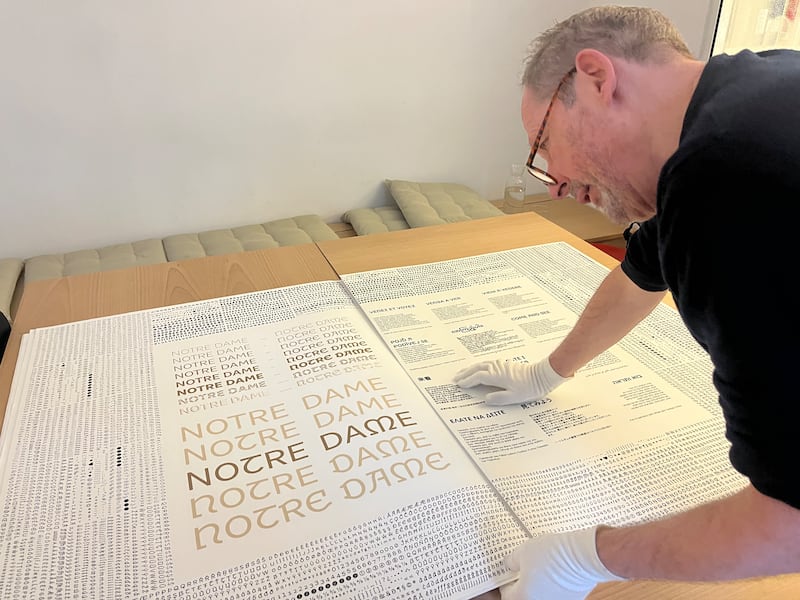Everyone who witnessed it burning that evening in April 2019 remembers the shocking scene of smoke pouring up from the cathedral into the Paris skyline.
Initially the timeline set by French president Emmanuel Macron seemed overly ambitious, but 5½ years later the restored Notre-Dame was reopened.
Some 2,000 workers and craftsmen were involved in the effort, which stretched from stone quarries in the regions of Oise and Aisne in northern France, carving workshops in Alsace, to the hundreds of sculptors, carpenters, painters, roofers, supervisors, scaffolders, organ builders and others who toiled on the site.
The early focus was on securing the cathedral’s structure, its oak-timbered medieval roof and 96m spire having been destroyed by the blaze, before they could move on to the work of rebuilding.
Philippe Jiraud, a sculptor from Normandy, was called in to lend a hand in the summer of 2023.
“I work on my own, but I was asked by big firms who did the sculptures in Notre-Dame to help them, so I worked on sculptures. I didn’t do the gargoyles or the statues, but I worked on the decorations on the exterior,” he says.
“We had to carve new stones. In my workshop we had three pieces of stone each more than a tonne, which were extracted from quarries, and we had to carve them the same as they were before the fire,” Jiraud says.
Due to the tight time frame to complete the work, craftsmen from different trades were working side by side, rather than one after the other.
“It was very moving to see it finished,” he says.
Laurent Ungerer, a graphic designer, can pick out Notre-Dame from one of the windows of his Paris home.
“So I saw the fire from the window. It’s burning in front of you, it never happened in my life, to see something and you don’t believe what you are seeing,” he says.

About a year after the fire he was drafted on to a team working on the creative side of things, to reorder the interior of the cathedral and design new branding and signage.
“The first year we only had discussions, we didn’t draw anything,” Ungerer says.
Everyone involved in the Notre-Dame project felt a sense of history in the room.
“It happens only once, it’s the project of our life,” he says.
There was resistance to any change to the designs of Eugène Viollet-le-Duc, the architect who led the last major restoration of the cathedral in the mid-1800s. So the creative team was kept under tight control, he says.
Macron at times controversially proposed more modern changes.
“Macron is somebody who wants to sign something . . . to add his signature in a creative way, like a king,” Ungerer says.
As part of the branding overhaul they created a new font, which they called Notre-Dame. The style of text combines a Latin typeface commonly seen in churches, known for its straight lines that were easier to cut into stone, with an older more flourishing one seen in the Book of Kells. So much so that the “t” in the new Notre-Dame logo is “an Irish t”, Ungerer says.
The restoration was a “superb” achievement, says Sr Marie Helene, a nun volunteering to help shepherd crowds of visitors through the cathedral.
“This cathedral is not only for Christians, it’s for everyone . . . That’s what I find beautiful,” she says.
As he stood among other world leaders at the grand reopening in early December, the moment should have been one of political triumph for Macron.
Coming on the back of a successful Paris Olympics earlier that summer, any national leader would have expected a bounce in popularity. In France the president’s stock has fallen so low he saw little immediate return.
Things might have been different had Macron not gambled on snap parliamentary elections in June, which nearly handed power to Marine Le Pen’s far right National Rally.
The anti-immigration party was kept out by a coalition of the left, who united under a common New Popular Front banner. The final result was a divided National Assembly where no camp could muster a majority.
A minority government led by conservative Michel Barnier collapsed after three months. The next prime minister, centrist Francois Bayrou, was able to scrape a budget over the line earlier this month, but is surviving on the grace of the far right and the centre left Socialist Party.
At a recent summit on artificial intelligence in Paris, Macron talked about replicating the “Notre-Dame de Paris” strategy, to get France into the global tech race.
“We showed the rest of the world that when we commit to a clear timeline we can deliver. You decide, you streamline all the procedures, somebody is in charge and you deliver,” he said.
That vision for a new get-things-done approach would look a lot more credible if French politics was not locked in a near permanent state of crisis. For that Macron only has himself to blame.















